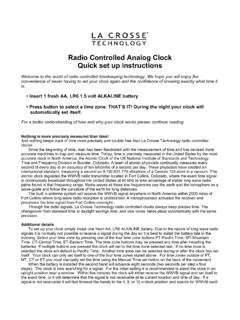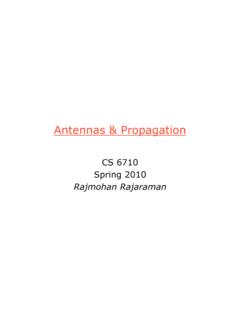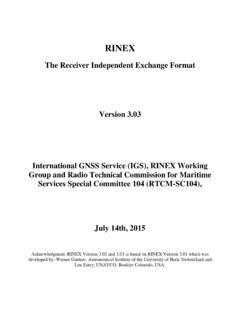Transcription of ATP 6-02.53 TECHNIQUES FOR TACTICAL RADIO …
1 ATP TECHNIQUES FOR TACTICAL RADIO OPERATIONS FEBRUARY 2020 DISTRIBUTION RESTRICTION: Approved for public release; distribution is unlimited. This publication supersedes ATP , dated 7 January 2016. Headquarters, Department of the Army This publication is available at the Army Publishing Directorate Website ( ) and the Central Army Registry site ( ). *ATP RESTRICTION: Approved for public release; distribution is unlimited. *This publication supersedes ATP , dated 7 January i Army TECHNIQUES Publication No. Headquarters Department of the Army Washington, DC, 13 February 2020 TECHNIQUES for TACTICAL RADIO Operations Contents Page vii INTRODUCTION .. ix Chapter 1 OVERVIEW .. 1-1 TACTICAL Radios .. 1-1 TACTICAL RADIO Networks .. 1-2 Network Management Planning Tools .. 1-4 Capabilities .. 1-6 Land Mobile RADIO .. 1-6 Combat Survivor Evader Locator .. 1-7 Chapter 2 TACTICAL RADIO EMPLOYMENT BY ECHELON .. 2-1 Combatant Commander Communications Team .. 2-1 Signal Command (Theater).
2 2-3 Corps and Below .. 2-4 Special Operations Forces .. 2-5 TACTICAL Command Post .. 2-6 Chapter 3 TACTICAL RADIO PLATFORMS .. 3-1 Section I Legacy and Enduring RADIO Platforms .. 3-1 Single-Channel Ground and Airborne RADIO System .. 3-1 Defense Advanced Global Positioning System Receiver .. 3- 12 MicroLight Personal Software-Defined Networked RADIO .. 3- 13 High Frequency Radios .. 3- 13 Blue Force Tracking .. 3- 18 Force XXI Battle Command, Brigade and Below Joint Battle Command Platform . 3- 19 Force XXI Battle Command, Brigade and Below Joint Capabilities Release .. 3- 19 Section II Software Defined RADIO Platforms .. 3- 19 Handheld Manpack Small Form Fit .. 3- 20 Manpack RADIO .. 3- 21 Chapter 4 WAVEFORMS AND WAVEFORM APPLICATIONS .. 4-1 Lower Tier Waveforms .. 4-1 Waveform Applications .. 4-2 Chapter 5 VHF RADIOS .. 5-1 Multiband Inter/Intra Team RADIO .. 5-1 Wideband Networking Handheld RADIO .. 5-2 Multichannel Manpack RADIO .. 5-3 Preface ii ATP 13 February 2020 Chapter 6 ULTRAHIGH FREQUENCY RADIOS.
3 6-1 Multifunctional Information Distribution System .. 6-1 TACTICAL Digital Information Link Joint Terminals .. 6-1 Joint TACTICAL Information Distribution System .. 6-2 Battlefield Awareness and Targeting System-Dismounted .. 6-3 Chapter 7 AIRBORNE RADIOS .. 7-1 AN/ARC-201 RADIO .. 7-1 AN/ARC-210 RADIO .. 7-1 AN/ARC-220 RADIO .. 7-2 AN/ARC-231 RADIO .. 7-2 AN/ARC-186 RADIO .. 7-3 Chapter 8 ANTENNA TECHNIQUES .. 8-1 Antenna TECHNIQUES Overview .. 8-1 High Frequency Antenna Location Considerations .. 8-1 Ground Effects .. 8-9 Grounded Antenna Theory .. 8- 10 Antenna Length .. 8- 12 Antenna Orientation .. 8- 13 Improvement of Marginal Communications .. 8- 15 Types of Antennas .. 8- 15 Field Repair .. 8- 30 Chapter 9 TACTICAL RADIO KEY MANAGEMENT .. 9-1 Key Management Infrastructure .. 9-1 Key Distribution .. 9-2 Automated Communications Engineering Software .. 9-2 Loadsets .. 9-4 Chapter 10 ELECTRONIC WARFARE AND PROTECTION TECHNIQUES .. 10-1 Electronic Warfare .. 10-1 Electronic Protection Responsibilities.
4 10-3 Communications Planning Process .. 10-5 Signal Security .. 10-7 Emission Control .. 10-7 Preventive Electronic Protection TECHNIQUES .. 10-8 Single-Channel Ground and Airborne RADIO System Anti-Jamming .. 10-14 Electronic Warfare for Single-Channel TACTICAL Satellite .. 10-15 Counter RADIO -Controlled Improvised Explosive Device Electronic Warfare .. 10-17 Purposeful Interference .. 10-17 Electromagnetic Interference .. 10-17 Appendix A FREQUENCY MODULATION RADIO NETWORKS .. A-1 Appendix B SINGLE-CHANNEL RADIO COMMUNICATIONS TECHNIQUES .. B-1 Appendix C ANTENNA SELECTION .. C-1 Appendix D COMMUNICATIONS IN AUSTERE ENVIRONMENTS .. D-1 Appendix E JULIAN DATE, SYNCHRONIZATION TIME, AND TIME CONVERSION .. E-1 Appendix F RADIO COMPROMISE RECOVERY PROCEDURES .. F-1 Appendix G DATA COMMUNICATIONS .. G-1 Appendix H COSITE INTERFERENCE .. H-1 Appendix I RADIO OPERATING PROCEDURES .. I-1 Appendix J FIELD REPAIR OF ANTENNAS .. J -1 Preface 13 February 2020 ATP iii Appendix K SINGLE-CHANNEL TACTICAL SATELLITE COMMUNICATIONS.
5 K-1 GLOSSARY .. Glossary-1 REFERENCES .. References-1 INDEX .. Index-1 Figures Figure 3-1. Retransmission operations .. 3- 10 Figure 3-2. Defense Advanced Global Positioning System receiver .. 3- 13 Figure 8-1. Transmitter and receiver connection example .. 8-2 Figure 8-2. Components of electromagnetic waves .. 8-3 Figure 8-3. Solid radiation patterns .. 8-4 Figure 8-4. Vertically polarized wave .. 8-5 Figure 8-5. Horizontally polarized wave .. 8-6 Figure 8-6. Circular polarization .. 8-7 Figure 8-7. Antenna take-off angle .. 8-9 Figure 8-8. Quarter-wave antenna connected to ground .. 8- 10 Figure 8-9. Wire counterpoise .. 8- 12 Figure 8-10. Beamwidth .. 8- 14 Figure 8-11. Example of a declination diagram .. 8 - 14 Figure 8-12. Near-vertical incidence skywave antenna, AS-2259/GR .. 8- 16 Figure 8-13. V antenna .. 8- 17 Figure 8-14. Vertical half-rhombic antenna .. 8 - 18 Figure 8-15. Long-wire antenna .. 8- 19 Figure 8-16. Sloping-V antenna .. 8- 20 Figure 8-17. Inverted L antenna.
6 8- 21 Figure 8-18. Near-vertical incidence skywave propagation .. 8- 22 Figure 8-19. Whip antenna .. 8- 23 Figure 8-20. Whip antennas mounted on a 8- 24 Figure 8-21. OE-303 half-rhombic VHF antenna .. 8- 26 Figure 8-22. Half-wave dipole (doublet) antenna .. 8- 27 Figure 8-23. Center-fed half-wave antenna .. 8 - 28 Figure 8-24. Improvised vertical half-wave antenna .. 8- 29 Figure 8-25. Field repair of broken whip antennas .. 8- 31 Figure 8-26. Examples of field expedient antenna insulators .. 8- 32 Figure 8-27. Repaired antenna guy lines and masts .. 8- 33 Figure 10-1. Local interference resolution (Army victim) .. 10-19 Figure 10-2. Interference resolution (Army source) .. 10-20 Figure A-1. Structure of a division command network ..A-3 Figure A-2. Example of a brigade administrative and logistics Figure A-3. Example of a division operations and intelligence communications Preface iv ATP 13 February 2020 Figure A-4. Example of a corps medical operations network.
7 A-6 Figure A-5. Example of a medical operations network in a division .. A-7 Figure A-6. Example of a division sustainment area command network .. A-8 Figure A-7. Example of a division HF command network .. A-9 Figure A-8. Example of a cavalry squadron HF data network .. A- 10 Figure B-1. Radiation of RADIO waves from a vertical antenna .. B-3 Figure B-2. Wavelength of a RADIO wave .. B-3 Figure B-3. Principal paths of RADIO waves .. B-4 Figure B-4. Possible routes for ground waves .. B-4 Figure B-5. Average layer distribution of the ionosphere .. B-6 Figure B-6. Skywave transmission paths .. B-8 Figure B-7. Skywave transmission hop B-9 Figure B-8. Wave shapes .. B- 13 Figure B-9. Amplitude modulation system .. B- 14 Figure B-10. Single-sideband system .. B- 15 Figure C-1. 32-foot vertical whip, vertical antenna pattern .. C-3 Figure E-1. World time zone map .. E-5 Figure H-1. Possible antenna stacks .. H-3 Figure J-1. Field repair of broken whip antennas .. J-1 Figure J-2. Examples of field expedient antenna insulators.
8 J-2 Figure J-3. Repaired antenna guy lines and masts .. J-3 Figure K-1. Single-Channel Anti-Jam Man-Portable terminal interface with combat net RADIO .. K-4 Tables Table 3-1. Comparison of SINCGARS versions and components .. 3-3 Table 3-2. SINCGARS enhancements comparison .. 3-5 Table 3-2. SINCGARS enhancements comparison (continued) .. 3-6 Table 3-3. Minimum antenna separation distance .. 3- 11 Table 3-4. AN/VRC-100 configurations .. 3- 15 Table 3-5. Automatic link establishment system handshake .. 3- 17 Table 3-6. Notional link quality analysis matrix for a RADIO (B3B) .. 3- 17 Table 8-1. Antenna length calculations .. 8- 13 Table 8-2. Leg angle for V antennas .. 8- 18 Table 8-3. Frequency and inverted L horizontal element length .. 8- 20 Table 8-4. OE-254 planning ranges .. 8- 25 Table 9-1. Initializing Automated Communications Engineering Software or communications-electronics operating instructions and signal operating instructions data .. 9-4 Table 10-1. TECHNIQUES for minimizing transmissions and transmission times.
9 10-9 Table 10-2. Common jamming signals .. 10-12 Table 10-3. Army interference resolution program functions .. 10-18 Preface 13 February 2020 ATP v Table 10-4. Joint spectrum interference resolution security classification guide .. 10-21 Table 10-5. Joint spectrum interference resolution information requirements .. 10-22 Table A-1. Example of division command networks ..A-2 Table B-1. Surface Table B-2. Ionosphere layers ..B-6 Table B-3. Regular variations of the ionosphere ..B-7 Table B-4. Irregular variations of the ionosphere ..B-7 Table C-1. Take-off angle versus distance .. C -2 Table C-2. HF antenna selection matrix .. C-4 Table E-1. Two-digit Julian date calendar (regular year) ..E-2 Table E-2. Two-digit Julian date calendar (leap year) ..E-3 Table E-3. Example of world time zone conversion (standard time) ..E-4 Table F-1. Compromised network recovery procedures: compromised transmission encryption keys and key encryption keys .. F-2 Table F-2. Compromised network recovery procedures: compromised transmission encryption keys F-3 Table H-1.
10 Transmitters and transmission range with and without the frequency hopping multiplexer .. H-4 Table I-1. Phonetic alphabet .. I-1 Table I-2. Numerical pronunciation .. I-2 Table I-3. Numerals in combinations .. I-2 Table I-4. Procedure words listed alphabetically .. I -3 Table K-1. AN/PSC-5/C/D, AN/PRC-117F and AN/ARC-231 line of sight interoperability ..K-7 Table K-2. AN/PSC-5/C/D, AN/ARC-231 and AN/PRC-117F ..K-8 This page intentionally left blank. 13 February 2020 ATP vii Preface ATP is the primary doctrine publication for TACTICAL radios and TACTICAL RADIO networks. This publication describes the non-prescriptive methods to perform missions, functions, and tasks for the employment of TACTICAL RADIO networks to support every warfighting function and enable command and control of Army forces. This publication includes doctrine on new communications and networking capabilities. It addresses the employment of interdependent and interoperable enterprise and TACTICAL systems in the TACTICAL network.



















